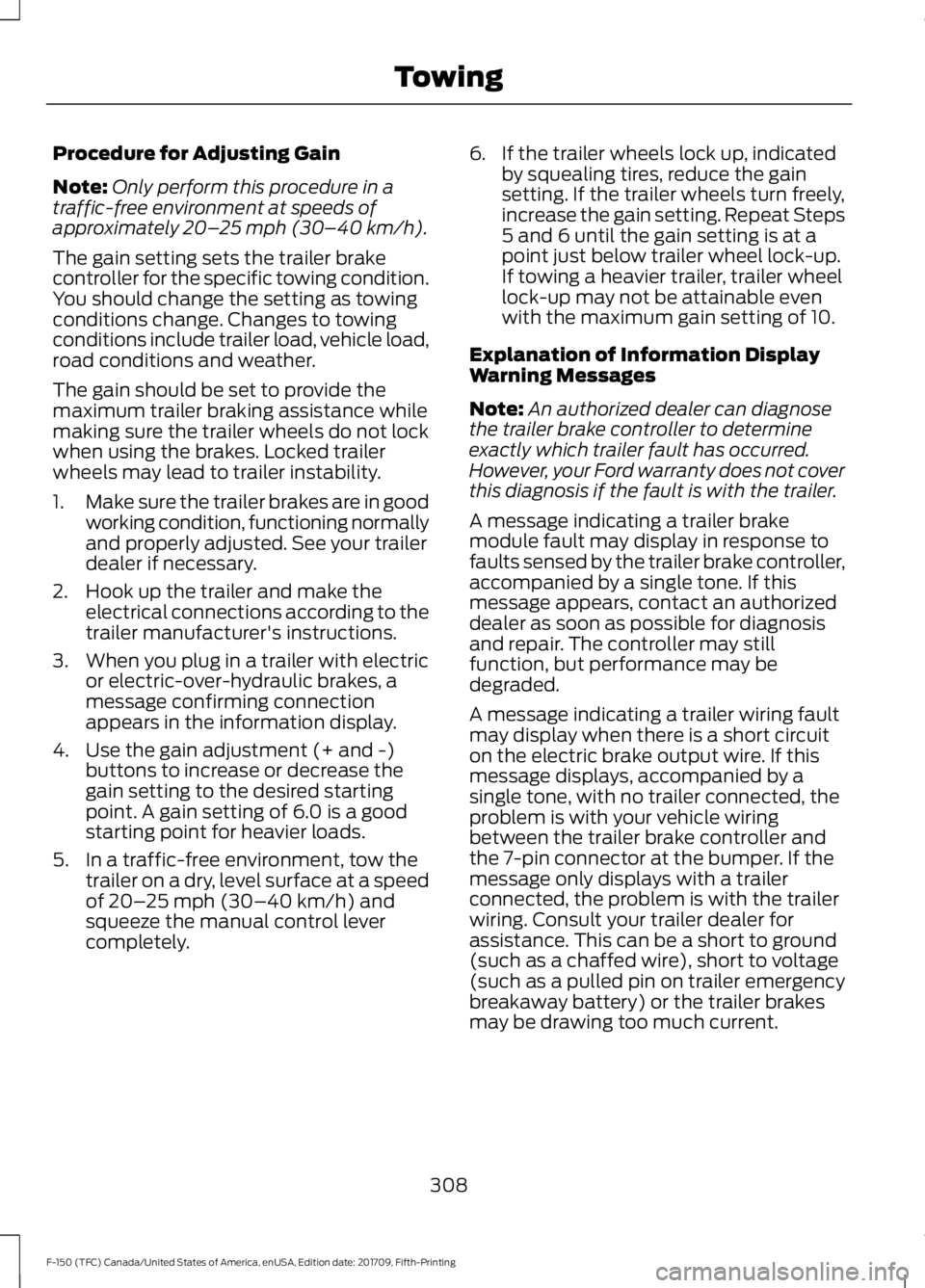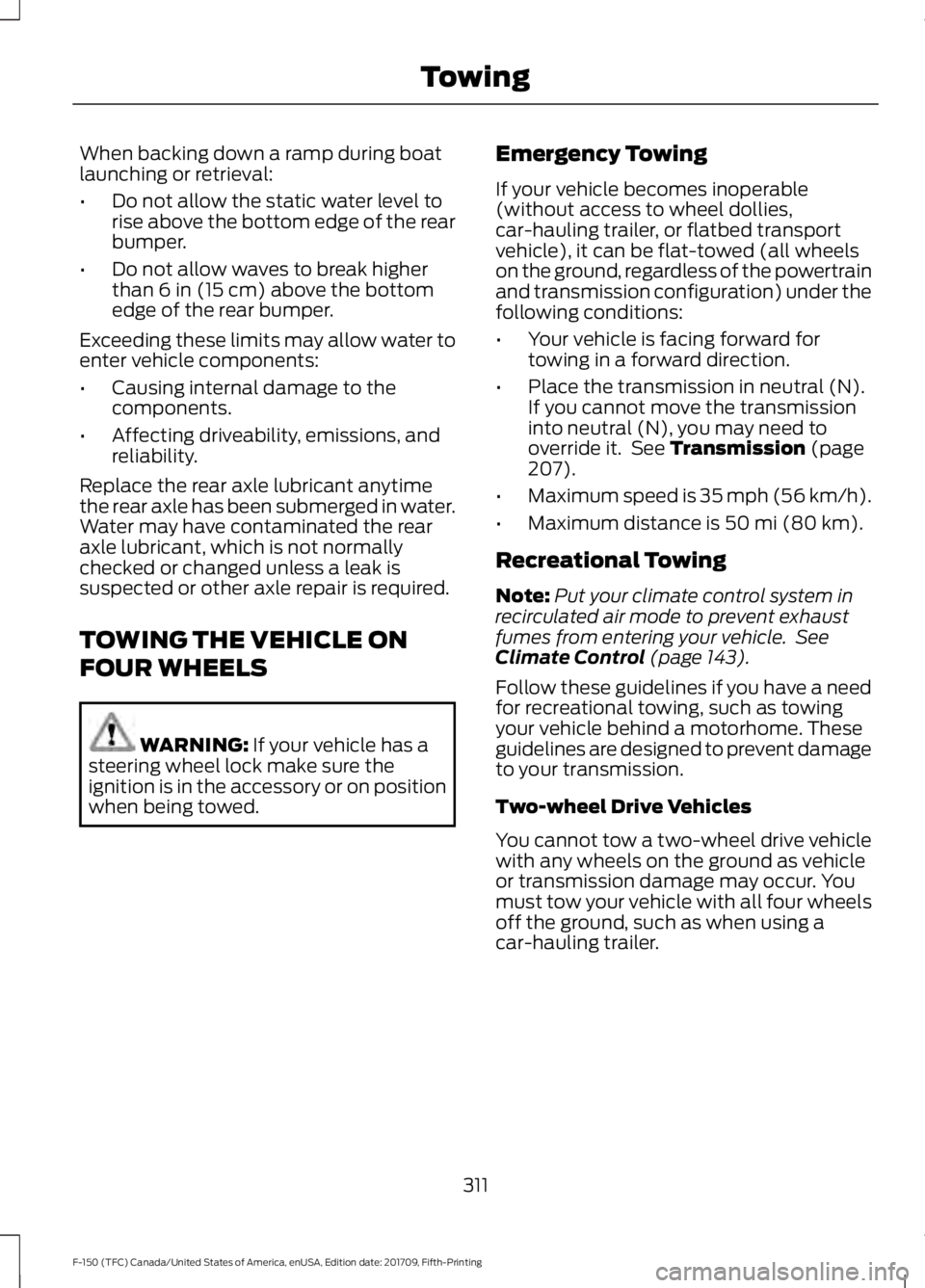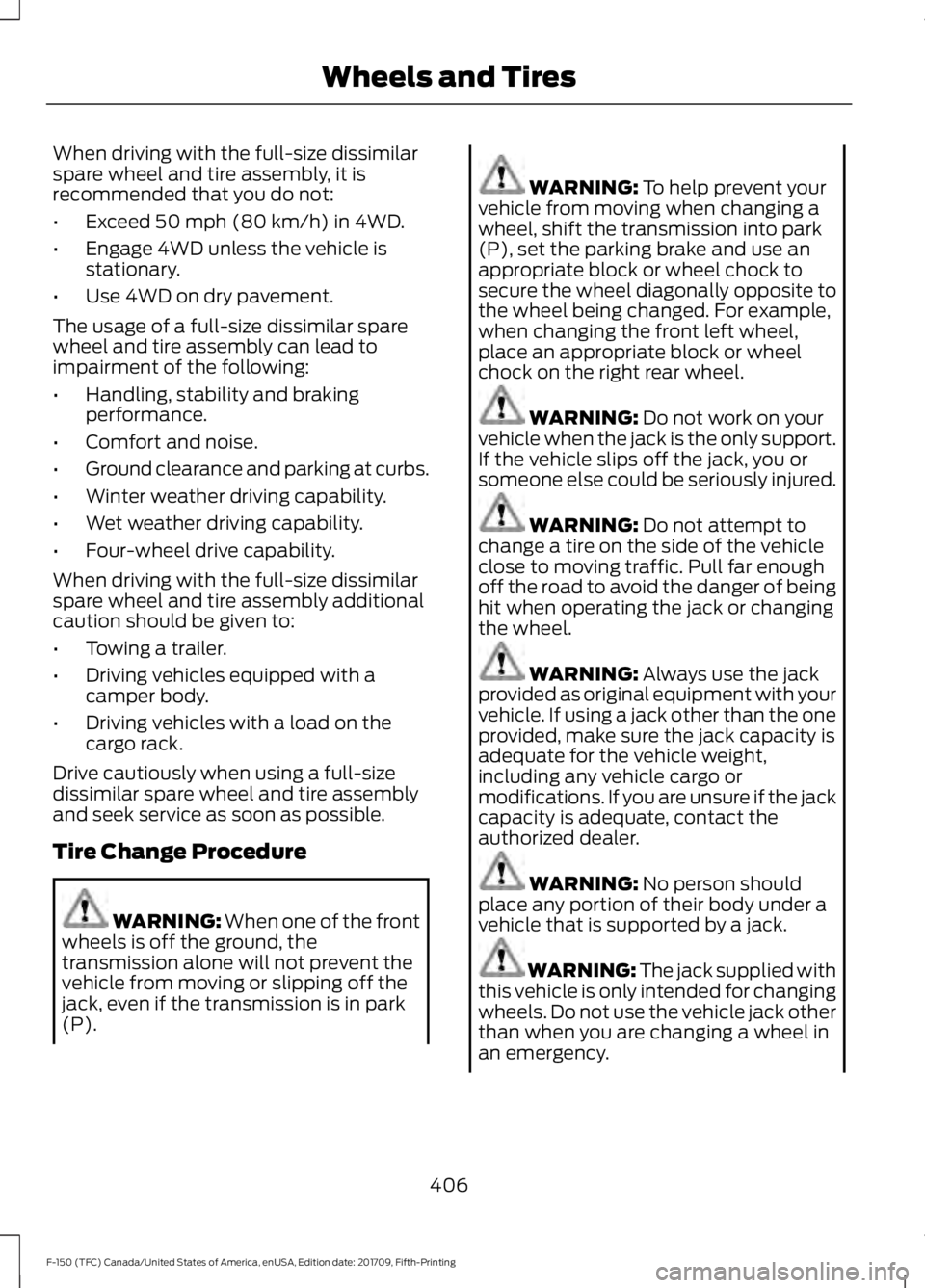2018 FORD F-150 emergency towing
[x] Cancel search: emergency towingPage 311 of 641

Procedure for Adjusting Gain
Note:
Only perform this procedure in a
traffic-free environment at speeds of
approximately 20– 25 mph (30–40 km/h).
The gain setting sets the trailer brake
controller for the specific towing condition.
You should change the setting as towing
conditions change. Changes to towing
conditions include trailer load, vehicle load,
road conditions and weather.
The gain should be set to provide the
maximum trailer braking assistance while
making sure the trailer wheels do not lock
when using the brakes. Locked trailer
wheels may lead to trailer instability.
1. Make sure the trailer brakes are in good
working condition, functioning normally
and properly adjusted. See your trailer
dealer if necessary.
2. Hook up the trailer and make the electrical connections according to the
trailer manufacturer's instructions.
3. When you plug in a trailer with electric or electric-over-hydraulic brakes, a
message confirming connection
appears in the information display.
4. Use the gain adjustment (+ and -) buttons to increase or decrease the
gain setting to the desired starting
point. A gain setting of 6.0 is a good
starting point for heavier loads.
5. In a traffic-free environment, tow the trailer on a dry, level surface at a speed
of
20– 25 mph (30–40 km/h) and
squeeze the manual control lever
completely. 6. If the trailer wheels lock up, indicated
by squealing tires, reduce the gain
setting. If the trailer wheels turn freely,
increase the gain setting. Repeat Steps
5 and 6 until the gain setting is at a
point just below trailer wheel lock-up.
If towing a heavier trailer, trailer wheel
lock-up may not be attainable even
with the maximum gain setting of 10.
Explanation of Information Display
Warning Messages
Note: An authorized dealer can diagnose
the trailer brake controller to determine
exactly which trailer fault has occurred.
However, your Ford warranty does not cover
this diagnosis if the fault is with the trailer.
A message indicating a trailer brake
module fault may display in response to
faults sensed by the trailer brake controller,
accompanied by a single tone. If this
message appears, contact an authorized
dealer as soon as possible for diagnosis
and repair. The controller may still
function, but performance may be
degraded.
A message indicating a trailer wiring fault
may display when there is a short circuit
on the electric brake output wire. If this
message displays, accompanied by a
single tone, with no trailer connected, the
problem is with your vehicle wiring
between the trailer brake controller and
the 7-pin connector at the bumper. If the
message only displays with a trailer
connected, the problem is with the trailer
wiring. Consult your trailer dealer for
assistance. This can be a short to ground
(such as a chaffed wire), short to voltage
(such as a pulled pin on trailer emergency
breakaway battery) or the trailer brakes
may be drawing too much current.
308
F-150 (TFC) Canada/United States of America, enUSA, Edition date: 201709, Fifth-Printing Towing
Page 314 of 641

When backing down a ramp during boat
launching or retrieval:
•
Do not allow the static water level to
rise above the bottom edge of the rear
bumper.
• Do not allow waves to break higher
than 6 in (15 cm) above the bottom
edge of the rear bumper.
Exceeding these limits may allow water to
enter vehicle components:
• Causing internal damage to the
components.
• Affecting driveability, emissions, and
reliability.
Replace the rear axle lubricant anytime
the rear axle has been submerged in water.
Water may have contaminated the rear
axle lubricant, which is not normally
checked or changed unless a leak is
suspected or other axle repair is required.
TOWING THE VEHICLE ON
FOUR WHEELS WARNING:
If your vehicle has a
steering wheel lock make sure the
ignition is in the accessory or on position
when being towed. Emergency Towing
If your vehicle becomes inoperable
(without access to wheel dollies,
car-hauling trailer, or flatbed transport
vehicle), it can be flat-towed (all wheels
on the ground, regardless of the powertrain
and transmission configuration) under the
following conditions:
•
Your vehicle is facing forward for
towing in a forward direction.
• Place the transmission in neutral (N).
If you cannot move the transmission
into neutral (N), you may need to
override it. See
Transmission (page
207).
• Maximum speed is 35 mph (56 km/h).
• Maximum distance is
50 mi (80 km).
Recreational Towing
Note: Put your climate control system in
recirculated air mode to prevent exhaust
fumes from entering your vehicle. See
Climate Control
(page 143).
Follow these guidelines if you have a need
for recreational towing, such as towing
your vehicle behind a motorhome. These
guidelines are designed to prevent damage
to your transmission.
Two-wheel Drive Vehicles
You cannot tow a two-wheel drive vehicle
with any wheels on the ground as vehicle
or transmission damage may occur. You
must tow your vehicle with all four wheels
off the ground, such as when using a
car-hauling trailer.
311
F-150 (TFC) Canada/United States of America, enUSA, Edition date: 201709, Fifth-Printing Towing
Page 409 of 641

When driving with the full-size dissimilar
spare wheel and tire assembly, it is
recommended that you do not:
•
Exceed 50 mph (80 km/h) in 4WD.
• Engage 4WD unless the vehicle is
stationary.
• Use 4WD on dry pavement.
The usage of a full-size dissimilar spare
wheel and tire assembly can lead to
impairment of the following:
• Handling, stability and braking
performance.
• Comfort and noise.
• Ground clearance and parking at curbs.
• Winter weather driving capability.
• Wet weather driving capability.
• Four-wheel drive capability.
When driving with the full-size dissimilar
spare wheel and tire assembly additional
caution should be given to:
• Towing a trailer.
• Driving vehicles equipped with a
camper body.
• Driving vehicles with a load on the
cargo rack.
Drive cautiously when using a full-size
dissimilar spare wheel and tire assembly
and seek service as soon as possible.
Tire Change Procedure WARNING:
When one of the front
wheels is off the ground, the
transmission alone will not prevent the
vehicle from moving or slipping off the
jack, even if the transmission is in park
(P). WARNING:
To help prevent your
vehicle from moving when changing a
wheel, shift the transmission into park
(P), set the parking brake and use an
appropriate block or wheel chock to
secure the wheel diagonally opposite to
the wheel being changed. For example,
when changing the front left wheel,
place an appropriate block or wheel
chock on the right rear wheel. WARNING:
Do not work on your
vehicle when the jack is the only support.
If the vehicle slips off the jack, you or
someone else could be seriously injured. WARNING:
Do not attempt to
change a tire on the side of the vehicle
close to moving traffic. Pull far enough
off the road to avoid the danger of being
hit when operating the jack or changing
the wheel. WARNING:
Always use the jack
provided as original equipment with your
vehicle. If using a jack other than the one
provided, make sure the jack capacity is
adequate for the vehicle weight,
including any vehicle cargo or
modifications. If you are unsure if the jack
capacity is adequate, contact the
authorized dealer. WARNING:
No person should
place any portion of their body under a
vehicle that is supported by a jack. WARNING: The jack supplied with
this vehicle is only intended for changing
wheels. Do not use the vehicle jack other
than when you are changing a wheel in
an emergency.
406
F-150 (TFC) Canada/United States of America, enUSA, Edition date: 201709, Fifth-Printing Wheels and Tires
Page 638 of 641

Special Operating Conditions Scheduled
Maintenance...............................................567
Diesel Engine...................................................... 569
Exceptions............................................................ 573
Speed Control See: Cruise Control........................................... 244
Spot Lamps.....................................................95
Cargo and Trailer Hookup Lamps.................. 95
Stability Control
...........................................228
Principle of Operation...................................... 228
Starter Switch See: Ignition Switch........................................... 170
Starting a Diesel Engine
.............................175
........................................................................\
............ 175
Automatic Engine Shutdown......................... 176
Cold Weather Operation................................... 177
Cold Weather Starting...................................... 176
Diesel Engine Fast Start Glow Plug System............................................................... 176
Vehicles with Keyless Start............................. 175
Starting a Gasoline Engine........................172 Automatic Engine Shutdown......................... 174
Failure to Start...................................................... 173
Guarding Against Exhaust Fumes................175
Important Ventilating Information...............175
Stopping the Engine When Your Vehicle is Moving................................................................ 174
Stopping the Engine When Your Vehicle is Stationary.......................................................... 174
Vehicles with an Ignition Key.......................... 172
Vehicles with Keyless Start............................. 172
Starting and Stopping the Engine..........170 General Information.......................................... 170
Steering...........................................................264 Electric Power Steering................................... 264
Steering Wheel Lock - Vehicles With: Push Button Start.......................................171
Unlocking the Steering Wheel........................ 172
Steering Wheel Lock - Vehicles Without: Push Button Start.......................................171
Steering Wheel
...............................................84
Storage Compartments............................168
Sunroof See: Moonroof..................................................... 103
Sun Visors
.......................................................103
Illuminated Vanity Mirror................................. 103
Supplementary Restraints System..........47 Principle of Operation......................................... 47Switching Off the Engine...........................179
Symbols Glossary
.............................................7
SYNC™ 3.......................................................480
General Information........................................ 480
SYNC™ 3 Troubleshooting......................542
SYNC™ Applications and Services........................................................467
911 Assist.............................................................. 468
SYNC Mobile Apps........................................... 469
SYNC™...........................................................463 General Information......................................... 463
SYNC™ Troubleshooting
..........................472
T
Tailgate Lock
....................................................73
Tailgate Step....................................................75
Closing the Step.................................................... 76
Opening the Step................................................. 75
Tailgate...............................................................73
Technical Specifications See: Capacities and Specifications.............415
The Better Business Bureau (BBB) Auto Line Program (U.S. Only)
......................330
Tire Care..........................................................384
Glossary of Tire Terminology........................ 385
Information About Uniform Tire Quality Grading............................................................. 384
Information Contained on the Tire Sidewall........................................................... 386
Temperature A B C............................................ 385
Traction AA A B C.............................................. 385
Treadwear............................................................ 384
Tire Pressure Monitoring System..........399 Changing Tires With a Tire Pressure
Monitoring System........................................ 401
Understanding Your Tire Pressure Monitoring System ....................................... 401
Tires See: Wheels and Tires..................................... 382
Towing a Trailer............................................280 Load Placement.................................................. 281
Towing Points................................................326
Towing the Vehicle on Four Wheels.......311 Emergency Towing.............................................. 311
Recreational Towing........................................... 311
Towing.............................................................280
635
F-150 (TFC) Canada/United States of America, enUSA, Edition date: 201709, Fifth-Printing Index